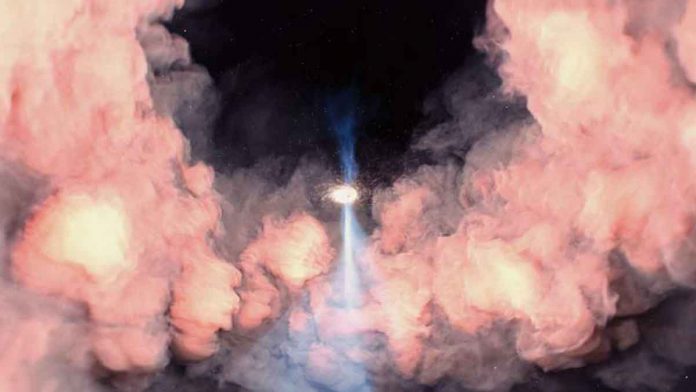High-energy neutrinos are enthralling subatomic particles created when extremely fast charged particles collide with other particles or photons. For nearly a decade, IceCube, a renowned neutrino detector located at the South Pole, has been detecting extragalactic high-energy neutrinos.
While many physicists have examined the IceCube detector’s observations, the origin of the majority of the high-energy neutrinos it detected has yet to be determined. These neutrinos were discovered beyond our galaxy and could be the result of a variety of cosmological events.
Researchers from Deutsches Elektronen Synchrotron DESY, Humboldt-Universität zu Berlin, and other academic institutions in Europe and the United States recently conducted a study on a specific violent cosmological event known as AT2019fdr. Their paper, which was published in Physical Review Letters, demonstrates that this event could be the source of a high-energy neutrino.
“For three years, our team has been conducting a systematic study in which we used the optical survey telescope of the Zwicky Transient Facility (ZTF) to scan the sky region of each new high-energy neutrino that we can observe,” Simeon Reusch, one of the study’s authors, told Phys.org. “Our recent paper investigates a possible source for one of these neutrinos, a massive optical outburst in a very distant galaxy known as AT2019fdr.”
The optical outburst studied by Reusch and his colleagues, AT2019fdr, is a transient event, which means it changes over time. The researchers investigated this occurrence thoroughly in order to determine its possible cause.
They concluded that AT2019fdr was most likely a tidal disruption event based on their analyses (TDE). TDEs happen when a star gets close enough to the supermassive black hole at the centre of a galaxy to be affected by it.
“As the star approaches the black hole, the gravitational pull in front of it is much stronger than in back, ripping the star apart,” explained Reusch. “Roughly half of the star’s mass is then accreted around the black hole, causing the debris to shine brightly for months.”
Reusch and his colleagues also attempted to determine whether AT2019fdr could be the source of the observed high-energy neutrino. They collaborated with theoretical physicists to model the source and make theoretical predictions based on their models.
“We tried to collect as much electromagnetic data on AT2019fdr as we could across a wide range of wavelengths,” Reusch explained. “We observed the location and gathered previously collected data in radio, infrared, optical, UV, X-ray, and gamma-ray wavelengths.”
The researchers examined both the AT2019fdr event and other possible sources of the high-energy neutrino they observed, all of which were located within a reasonable distance. Interestingly, they ruled out all sources except AT2019fdr due to their light curve (i.e., brightness profile over time) or optical spectra.
“The strong dust echo we detected is in the infrared range, which links AT2019fdr to a subclass of dust echo sources in galaxies’ centres,” Reusch explained. “The ‘echo’ is created when the intense radiation from the TDE heats the surrounding dust, causing it to glow in the infrared range. The system’s massive size causes time delays due to light travel times, which is why the peak of the dust echo is delayed in relation to the flare.”
Reusch and his colleagues also discovered a late-time X-ray signal with an extremely soft spectrum using the eROSITA aboard the SRG satellite. Overall, their measurements and theoretical analyses point to AT2019fdr as the source of the observed high-energy neutrino. Furthermore, the team’s findings suggest that AT2019fdr is a TDE rather than a superluminous supernova, a “regular” flare from the galaxy’s centre, or another type of cosmological event.
“Our findings are significant because our group previously identified a TDE (AT2019fdr) as the likely source of another high-energy neutrino,” Reusch added. “If these TDEs were indeed neutrino sources, they had to be very efficient at producing high-energy neutrinos. Multi-messenger studies, such as the one presented in our paper, provide insights into cosmic particle accelerators such as TDEs or AGN that photons alone cannot provide.”
The researchers will conduct additional analyses in their subsequent studies to validate their findings. They also intend to look for other TDEs in the large cosmological event dataset compiled by ZTF so far.

